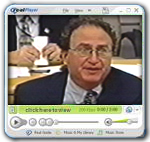Calit2 Associate Director Lenert Addresses NASA Sites, Others on Emergency Medical Preparedness
San Diego, CA, February 23, 2006 -- Leslie Lenert, associate director for biomedical informatics at the UCSD division of Calit2, last Friday gave an invited presentation on Calit2’s WIISARD project that was video broadcast to 14 NASA sites and others, including back to Calit2, in a session on “Interoperable Communications.” WIISARD stands for Wireless Internet Information System for Medical Response in Disasters, a project funded by the National Library of Medicine.
“WIISARD is gaining increasing prominence as a national model for disaster communications and management of medical data in disaster response,” said Lenert. “In the talk, I described the WIISARD system, our successes and lessons learned through deploying the system in three large-scale disaster drills, and our plans for system expansion. I also discussed the unique technologies developed for WIISARD at Calit2 and how the Calit2 approach differs from existing systems fielded by the Army, the Navy, and researchers working in other domains.”
|
Lenert's session was part of the 15th NASA International Continuing Health Education Series on “Emergency Health and Medical Preparedness and Response to Disasters.” This series seeks to educate physicians, nurses, health care executives, health scientists, engineers, industrial hygienists, and emergency medical technicians in all 14 NASA centers and facilities. In session 6 of this series, Lenert shared the spotlight with Kenneth Moran, from the Office of Homeland Security at the Federal Communications Commission, who addressed the topic of “Wireless Network & Satellite Radio Systems.”
Said Wing T. Chan, senior public health officer at NASA headquarters and organizer of this series, “NASA is very appreciative of Dr. Lenert’s contribution. He’s among 20 expert speakers from federal, state, and local agencies, and academic institutions that are at the forefront of disaster response. Lenert’s lecture is pivotal to educating our audience, which includes NASA health care providers, particularly those at Stennis and Kennedy space centers who have responded to hurricanes Katrina, Rita, and Wilma.”
The NASA international continuing health education program was initiated in July 1997 with primary objectives of providing distance education to NASA health professionals and promoting understanding and interaction among the partner countries involved in the International Space Station project missions. It was expanded subsequently to reach worldwide audience via live Internet broadcast.
|
A video-on-demand system is installed on the NASA website such that global viewers can access on all past videotaped educational series and their proceedings. Some 95 sessions (184 hours of lectures) have been offered with 187 national and international experts lecturing in the 13 series.
Participating agencies, institutions, universities and others have included the NASA centers; the Institute for Medical and Biological Problems, Moscow, Russia; Moscow State University; the European Institute of Telemedicine, Toulouse, France; Institut de Medecine et de Physiologie Spatiales, France; Universitaire de Medecine Communautaire, CHU de Grenoble, France; F. Edward Hebert School of Medicine, Uniformed Services University of the Health Sciences; Yale University; Robert C. Byrd Health Sciences Center, West Virginia University; Virginia Commonwealth University School of Medicine; and Scuola Superiore G. Reiss Romoli, Italy.
Exchange scholars, including physicians and health scientists from republics of the former Soviet Union (Armenia, Georgia, Kazakhstan, Kyrgyzstan, Ukraine, and Uzbekistan) and Romania, have been frequent participants through the East West Space Science Center at the University of Maryland.


